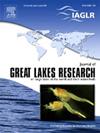Nearshore and embayment zooplankton community structure in Lake Michigan, implications for invasion by bigheaded carps
IF 2.4
3区 环境科学与生态学
Q3 ENVIRONMENTAL SCIENCES
引用次数: 0
Abstract
Zooplankton communities in Lake Michigan’s nearshore and embayment regions are important food sources for planktivorous and larval fish. Geographically extensive surveys of nearshore zooplankton abundance and composition are crucial for understanding spatial patterns in community structure and Lake Michigan’s food web. Over 400 zooplankton samples collected in 2013 and 2014 from 25 locations in Illinois, Michigan, and Wisconsin harbors, open waters, and drowned river mouth lakes of Lake Michigan were used to identify spatial and temporal patterns in zooplankton assemblages. Special focus was placed on the accurate collection of small-bodied taxa such as rotifers, copepod nauplii, and dreissenid veligers to explore the contribution of smaller taxa to total zooplankton biomass. Multivariate analysis identified zooplankton biomass and community structure in Green Bay, Wisconsin and Michigan drowned river mouth lakes as distinct from Illinois and Wisconsin harbor and nearshore areas. Our zooplankton biomass estimates were then applied to an existing bioenergetics model for bigheaded carps (Hypophthalmichthys nobilis and H. molitrix) to quantify their predicted growth, as a proxy for successful establishment in Lake Michigan. Locations where bigheaded carps were predicted to grow were consistent with patterns in zooplankton community structure and were restricted to a handful of sites in Green Bay and Michigan drowned river mouths. These results emphasize the importance of embayment zooplankton communities and small-bodied zooplankton as energy sources for both native and non-native fishes in an increasingly oligotrophic Lake Michigan.
密歇根湖近岸和堤坝浮游动物群落结构,对大头鲤入侵的影响
密歇根湖近岸和河口地区的浮游动物群落是食板鱼和幼鱼的重要食物来源。对近岸浮游动物的丰度和组成进行广泛的地理调查,对于了解群落结构和密歇根湖食物网的空间模式至关重要。2013 年和 2014 年从伊利诺伊州、密歇根州和威斯康星州的密歇根湖港口、开阔水域和淹没河口湖的 25 个地点收集了 400 多份浮游动物样本,用于确定浮游动物群落的空间和时间模式。重点是准确收集小体类群,如轮虫、桡足类稚虫和海鞘绒毛虫,以探索较小类群对浮游动物总生物量的贡献。多变量分析确定了绿湾、威斯康星州和密歇根州溺水河口湖泊的浮游动物生物量和群落结构与伊利诺伊州和威斯康星州港口及近岸区域的浮游动物生物量和群落结构。然后,我们将浮游动物生物量估算值应用于现有的大头鲤生物能模型(和),以量化其预测生长量,作为在密歇根湖成功建群的替代指标。预测大头鲤生长的地点与浮游动物群落结构的模式一致,并且仅限于格林湾和密歇根淹没河口的少数几个地点。这些结果强调了在日益寡营养的密歇根湖中,堤岸浮游动物群落和小型浮游动物作为本地和非本地鱼类的能量来源的重要性。
本文章由计算机程序翻译,如有差异,请以英文原文为准。
求助全文
约1分钟内获得全文
求助全文
来源期刊

Journal of Great Lakes Research
生物-海洋与淡水生物学
CiteScore
5.10
自引率
13.60%
发文量
178
审稿时长
6 months
期刊介绍:
Published six times per year, the Journal of Great Lakes Research is multidisciplinary in its coverage, publishing manuscripts on a wide range of theoretical and applied topics in the natural science fields of biology, chemistry, physics, geology, as well as social sciences of the large lakes of the world and their watersheds. Large lakes generally are considered as those lakes which have a mean surface area of >500 km2 (see Herdendorf, C.E. 1982. Large lakes of the world. J. Great Lakes Res. 8:379-412, for examples), although smaller lakes may be considered, especially if they are very deep. We also welcome contributions on saline lakes and research on estuarine waters where the results have application to large lakes.
 求助内容:
求助内容: 应助结果提醒方式:
应助结果提醒方式:


